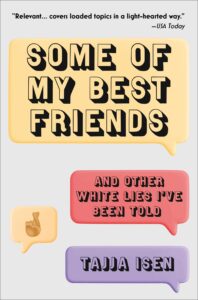
The Art of the Mini Sales Pitch: How to Subtitle Your Book So People Will Read It
Tajja Isen on Balancing the Demands of Marketing With Artistic Vision
About a year after my essay collection, Some of My Best Friends, was published, I got an email from my editor. Subject line: “Thinking caps, please: a new subtitle.” I’d known that this was coming. When we started kicking around ideas for the paperback, my team saw an opportunity to jazz things up. A new cover, a new subtitle. The hardback versions were beloved—by more than just me, I was reassured!—but it turns out that the original subtitle, Essays on Lip Service, had begun to strike people as a little too subtle.
“We want something that isn’t so vague,” my editor wrote, “and that very clearly tells you what you’re going to get in this collection: smart, incisive opinions; a perspective that may shift your own; some humor!” I love challenges like this; when you have to find the perfect way to sell a story to make it land with an audience. I also believe any exercise that asks you to compress your book into some sort of elevator pitch is never a wasted one. So, I was game, I was keen, I was dauntless. Even if a tiny part of me was miffed to discover I hadn’t gotten it right the first time.
Subtitles have become a mini sales pitch that obscures a book’s genre the way you might sneak a dog’s pills into a spoon of peanut butter.
The book is about the easy, lazy proliferation of social-justice language—how it’s funny when institutions slap it on like lipstick, how I’ve encountered that tendency in various industries I’ve worked in, and what that pattern tells us about what it means to be alive right now. With subject matter like that, I knew there was a high risk of being misread, or read uncharitably. If there was even the smallest chance the previous subtitle heightened that risk, then of course we should replace it.
I fired off some suggestions, knowing none were quite right but hoping, as a juicy brainstorm can, they would spark something even better from someone else and we’d keep one-upping until we struck gold: On the Limits of Good Intentions. Talk Is Cheap When the World Is on Fire. Sure, they were clunky, but maybe there was something there?
As the email chain went on, accumulating dozens of suggestions and incorporating the feedback of a widening gyre of stakeholders, the tone began to change. Every time I thought we might be getting close, a new problem sprung up, a steady whack-a-mole of fears that we might do something—or, worse, had already done something—to turn off a reader. There were more doubts brewing about the original subtitle than I’d realized. Lip service wasn’t just “vague,” it was also “academic.” In fact, so was essays. It was “hand-wringy.” It gave people “bad vibes.” It wasn’t punchy. It wasn’t funny, or it wasn’t funny enough. Actually, what if we just changed the title altogether?
As someone for whom the word essays is a huge incentive to pick up a book at all, this was very discouraging. I envied the titans of nonfiction, the Didions and the Sontags, who could slap the e-word on their book and be read as an enigmatic genius rather than a difficult scold. On one level, I knew this was just 20/20 hindsight colliding with the brutal logic of marketing. But this was a bit like finding out I’d been walking around in public with something smeared on my face and nobody told me until a year later.
Worse, I’d been walking around with the thing smeared on my face and thinking that it made me look cool. With Essays on Lip Service, I thought I was invoking an established tradition of nonfiction subtitles that signaled rigor and style. A way to assure the reader they were in for a good, smart time. It’s Slouching Toward Bethlehem: Essays. Not Slouching Toward Bethlehem: And Other Clever Thoughts I’ve Had While Being a Caustic White Lady.
Were Didion to publish her debut collection today, maybe that’s what it would have been called; the intellectual open-endedness implied by Essays or even A Memoir doesn’t really seem to fly anymore. Not to the same extent. Over the past few years, nonfiction subtitles have started trending more toward explicit description. They have become an informal barometer of market pressure; a microcosm for questions of commerce. It’s a truism that essay collections and memoirs by the non-famous are hard to break out. In response to this challenge, subtitles have become a mini-sales pitch that obscures a book’s genre the way you might sneak a dog’s pills into a spoon of peanut butter.
Of course, plenty of contemporary writers still get to subtitle their books essays or a memoir or even a memoir in essays. But an informal taxonomy suggests that numerous other patterns have sprung up in at least implied response to this market toughness. Because this is a very informal and vibes-based theory—this is an essay about the publishing industry, after all—it’s impossible to mark a fixed turning point.
But I’d guess that something changed in 2016, when Melissa Broder published So Sad Today. Subtitled Personal Essays, the modifier made clear that this was something different; an effort to clarify or distinguish the book’s contents in an essay market that was glutted even then. I always appreciate the modifier subtitle and the way it allows the writer to retain a little mystery. Heavy: An American Memoir. Notes from No-Man’s Land: American Essays. Thin Places: Essays from in-Between. “What does that mean?” I always wonder, and not in a way that gives me bad vibes or makes me wring my hands, but in a mood of genuine curiosity that propels me toward picking up a book.
The reason I agonized so much over the new subtitle was because I felt pulled between those two imperatives: the vision versus the sell.
Another popular strategy—one that I was hungry to recreate but was never able to find the right noun or verb to help me pull off—is to imbue the subtitle with a word that somehow gestures to the book’s theme or argument. Think Trick Mirror: Reflections on Self-Delusion. On Immunity: An Inoculation. Dirtbag, Massachusetts: A Confessional. This is chef’s kiss–level elegance. You get a taste of the case the book is going to make and the tone in which the writer’s going to make it. I reflect; I inoculate; I confess. It’s like an actor annotating a script and asking what does this character want and having that guiding intention accompany you through the text. But, for the life of me, I couldn’t find anything made of a comparable material that didn’t make me break out in hives.
What was I going do: Some of My Best Friends: A Microaggression? Some of My Best Friends: A Virtue Signal? (Okay, I admit, this is actually very close to one that somebody suggested.) I had tried to write a smart book about a subject that attracts a lot of dumb discourse. And, as the weeks wore on and we got no closer to finding a subtitle that seemed workable, I was really feeling that chasm.
All these choices offer different ways of addressing a very specific challenge: that of trying to capture a reader’s attention and stand out among the competition. The subtitle in particular feels like it embodies a critical choice that an artist has to make: How much are you willing to compromise in the name of the market? When it comes to what you’re willing to do to cut through the noise, the calculus—between your vision for the project and what you’re comfortable doing to sell it—is different for every person. It’s not like a website, where an editor can slap a click-baity headline on an essay and you don’t find out until you start getting harassed for it. Here, you get to sign off.
The reason I agonized so much over the new subtitle was because I felt pulled between those two imperatives: the vision versus the sell. The message I was getting about the original subtitle was that we had weighted things too far in the first direction. Now, we had to sell it more. I thought I’d figured out where my own personal lines of compromise lay. This was a request to redraw them.
I was struggling to do so, having drinks at my friend Matt Ortile’s house, when he threw me a lifeline: “What about And Other White Lies?” Matt had gone in a similar direction for his own collection, The Groom Will Keep His Name: And Other Vows I’ve Made About Race, Resistance, and Romance. “White lies” made me sit up and put my wineglass down. It was smart and sharp and it made me just uneasy enough that I knew marketing would love it.
The final subtitle, as it appears on the paperback, is And Other White Lies I’ve Been Told. This formulation, too, participates in an established trope—And Other Thoughts on Being a Woman (Nora Ephron); And Other Things I Still Have to Explain (Phoebe Robinson); And Other Thoughts I’ve Had While Being a Caustic White Lady (Joan Didion). There’s a certain anthropological prurience to these subtitles; the promise of a first-person voice to guide the reader through the experience of inhabiting a given subject position. It’s a note about which I still feel some lingering ambivalence. But it felt too fitting to pass up. Putting it on the book nudged at the limits of my comfort, but it didn’t feel like I was ceding ground on the integrity of the project. Ultimately, that was the most important thing.
__________________________________

Some of My Best Friends: And Other White Lies I’ve Been Told by Tajja Isen is now available in paperback from Atria/One Signal Publishers, an imprint of Simon & Schuster.
Featured image by Marco Verch is licensed under CC BY 2.0.
Tajja Isen
Tajja Isen is a Toronto-based writer and voice actor. She has written for Longreads, BuzzFeed, Broadly, Bitch, The Globe and Mail, Electric Literature, The Rumpus, and Catapult, where she is also a contributing editor.



















